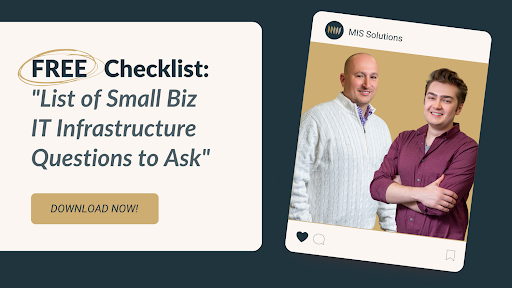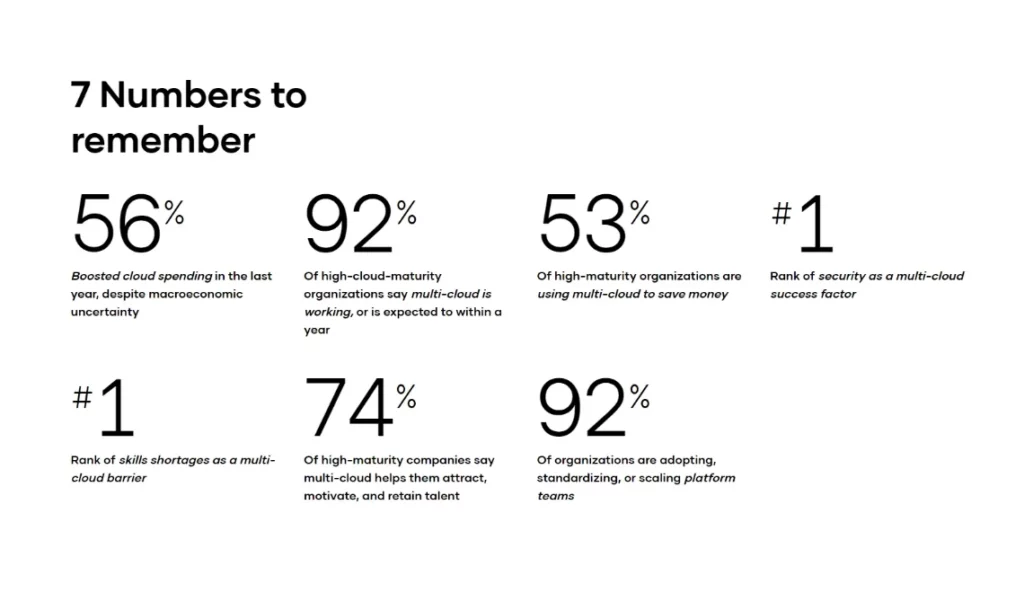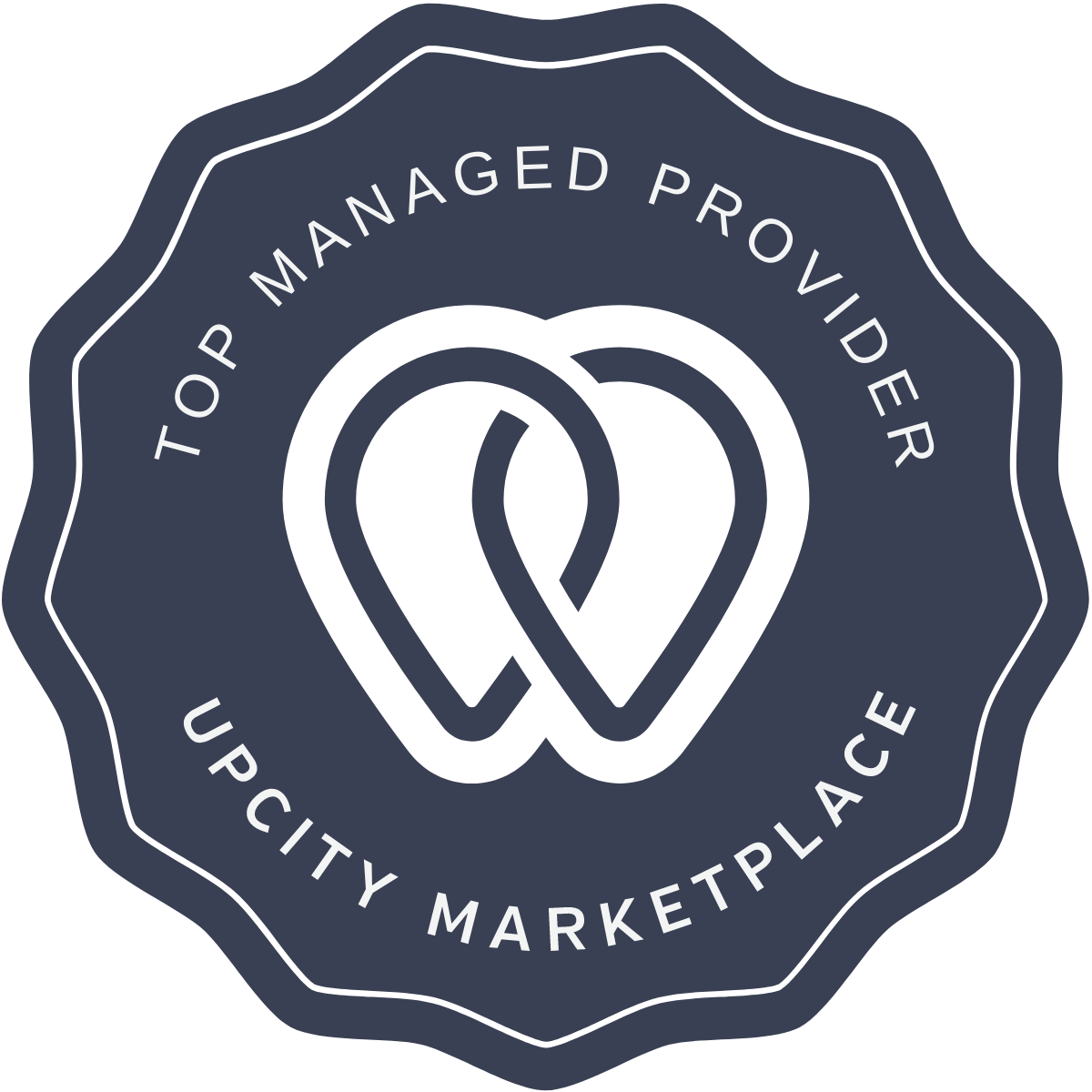Is your IT infrastructure holding your business back from its fullest potential?
Your tech infrastructure is the heart of your business. It influences your business productivity, costs, potential downtime, and even your overall security.
This is especially important for small businesses. Because, according to Insight:
-
- 27% of small businesses do NOT have an IT support.
-
- 80% of small businesses are using manual integration tools.
-
- 66% of small businesses would fail without wireless technology.
- 66% of small businesses would fail without wireless technology.
From roadmapping your IT to implementing it though, there are many different steps that you need to take into consideration.
Such as:
-
- Your operations.
-
- Business size and headcount.
-
- Hardware budget.
-
- What to do when you’re scaling and hiring more employees.
-
- What you need and what you actually don’t (this might surprise you, but almost 99% of small businesses are actually scalable.).
- What you need and what you actually don’t (this might surprise you, but almost 99% of small businesses are actually scalable.).
While the process is typically different for each business, there are elements that overlap and the bigger picture strategy is mostly the same.
So that you get the most value out of this article though, we’ll be focusing on practical steps.
Here’s what we’ll cover:
-
- What is an IT infrastructure and what small businesses need to keep in mind when it comes to their tech
-
- How to decide on the right IT tools as small business for your infrastructure, without breaking your budget
-
- When to consider moving your IT infrastructure to the cloud (and how this can help most businesses scale easily)
-
- Top 3 best practices and tips for your overall IT infrastructure and security (based on our proven processes)
- Top 3 best practices and tips for your overall IT infrastructure and security (based on our proven processes)
What Is An IT Infrastructure And Why Is It So Important For Small Businesses?
First things first, what IS an IT infrastructure, exactly?
Essentially, the term refers to all components that play a role in your overall IT-enabled operations. As in, the tech that impacts your day-to-day tasks and work.
The infrastructure is different for each business, but typically the main IT components include your:
-
- Hardware.
-
- Software.
-
- Network resources.
-
- Data storage and centers.
-
- Routers.
-
- Servers.
-
- And more, depending on your specific business.
- And more, depending on your specific business.
If you need help examining your IT infrastructure click to download our checklist made specifically for SMBs:

Now, one of the biggest challenges small businesses face with their infrastructure has to do with scaling.
As you scale your products or services and hire more employees, your IT infrastructure needs to scale with you.
In other words, things might be working perfectly fine now, but it’s important your IT infrastructure doesn’t hold you back from scaling as you grow.
For example, your wireless connection might be working fine now.
But as you scale, hire more employees, and introduce more hardware into the office – it slows down and doesn’t work as well as it should anymore.
This is only one obvious example, of course.
You can always buy more, high-quality hardware to support your IT infrastructure accordingly.
But in addition to the higher cost, there are other requirements you need to keep in mind, such as your:
-
- Network bandwidth – Your network bandwidth should be robust enough to handle increased data traffic and ensure seamless communication and connectivity.
-
- Storage capacity – As your small business grows, so does the amount of data you generate and store. You need to ensure you have sufficient storage capacity to avoid bottlenecks and data loss.
-
- Security measures – When scaling your workforce, you leave a larger digital footprint and the importance of cybersecurity rises as well. More people on the same connection means more potential weak spots. Implementing security measures such as firewalls, encryptions, access controls, and so on also becomes more important to protect sensitive business and customer data.
-
- And other scalable infrastructure – As your business grows, it’s crucial to invest in scalable infrastructure that can accommodate future expansion. You should look into technologies that allow easy scalability without significant disruptions. This way, you can adapt to changing business needs without much downtime or overhauls.
- And other scalable infrastructure – As your business grows, it’s crucial to invest in scalable infrastructure that can accommodate future expansion. You should look into technologies that allow easy scalability without significant disruptions. This way, you can adapt to changing business needs without much downtime or overhauls.
It might sound obvious, to replace hardware and software over time, but far too many businesses continue to operate without doing so.
For example, according to Health IT Security, 53% of healthcare devices still operate on Windows 7. This introduces new risks for the business, such as:
-
- Patient safety risks.
-
- Easier to hack because of the old operating system.
-
- Missing out on new features.
-
- And more.
- And more.
Meanwhile, here’s how your infrastructure can support you when scaling instead.
Benefits of the right IT infrastructure when scaling
Let’s say your business is growing and you want to make sure your infrastructure isn’t holding you back.
While it may sound convenient to just walk into Best Buy and grab a top-of-the-line product on sale, in most cases, small businesses end up overpaying for more than they need. Or they purchase something that doesn’t meet their expectations in terms of their roles and tasks.
A well-designed IT infrastructure is the backbone of any small business.
Let’s say you have 20 employees relying on 20 computers to perform their daily tasks.
The productivity of the entire operation depends on the stability and efficiency of the network infrastructure.
By prioritizing uptime, ensuring warranty coverage for devices, and standardizing systems, small businesses can optimize their overall business goals as well such as your overall:
-
- Operation KPIs.
-
- Overall ROI.
-
- Daily productivity.
-
- Customer expansion.
-
- Daily deliverables.
-
- And more
- And more
While it might be hard to pinpoint an exact number on the cost of downtime, it will affect your:
-
- Revenue.
-
- Productivity.
-
- Recovery costs.
-
- Employee costs.
-
- Customer impact.
-
- And intangible costs.
- And intangible costs.
So, there are many indirect costs as well.
According to Pingdom, the cost per minute for small business network downtime is around $427 per minute.
In short, as you scale your business (employees, goals, strategy), it’s important you scale your IT infrastructure alongside it.
For this, you’ll need the right set of tools and best practices that support your infrastructure.
Let’s take a look at how this works.
Deciding On The Right IT Tools As A Small Business For Your Infrastructure
To achieve the above benefits, it’s crucial you invest in the right IT tools.
And a lot of IT tools might look the same, but they’re really not.
Look at it this way:
All cars have four wheels, right?
But there’s an obvious difference between a Honda and a BMW.
Different people buy each model with different expectations.
The same goes for your IT tools and hardware.
Let’s take another example.
If you’ve got 50 employees and 20 computers, you’ve got 20 people working on 20 computers all day long.
The other 30 are working on machinery that relies on those computers.
So, the whole production and daily operations rely on your IT infrastructure backbone.
That is to say, the status of your PCs, their uptime, warranties, wireless access points, security, and more.
There’s a common misconception that only large corporations need a robust IT infrastructure.
This couldn’t be further from the truth. Even the smallest business benefit from an optimized technology setup.
When determining the IT needs of your business, you need to first identify what IT your business has.
This requires looking at how your existing employees are using your current technology. After this, you can start planning out your infrastructure.
A custom IT infrastructure done right takes into consideration how many employees you manage and what their workload is like.
You don’t need to go out and buy $5,000 laptops straightaway.
But there are certain people that do different tasks that require a little bit more machine power or a little less, depending on what they do.
For example, a customer support team primarily relies on communication tools to handle calls, emails, and live chats. In this case, a mid-range laptop or desktop that prioritizes reliability would work fine.
Developers, meanwhile, require powerful machines with good processing capabilities and strong specs.
Makes sense, right?
Then, as you scale, your equipment needs rise with you.
For example:
-
- More people using the same wireless connection means you might have to invest in stronger internet.
-
- Hiring people across different departments might need different kinds of computers (if you provide one).
-
- As your team expands, you’ll also need a bigger centralized data storage.
-
- Your security measures should also be tightened.
-
- And your productivity levels will depend on your collaboration and communication tools.
- And your productivity levels will depend on your collaboration and communication tools.
So, when scaling your infrastructure as a small business and you’re deciding on the right tools, one approach is to move your architecture to the cloud.
Here’s how this works.
Moving Your IT Infrastructure To The Cloud: What You Need To Know
Cloud solutions play an important role in the scalability of small businesses.
Whether it’s adding new locations or expanding your workforce, cloud-based systems offer a flexible solution with almost no downsides.
This is why 99% of small businesses we work with are absolutely scalable. Though, if they’re not, we always roadmap them to where they can be.
This also depends business-to-business, but the cloud offers many benefits it’s a no-brainer choice for almost all businesses.
We’ll take a look at the benefits and use cases below, but first, let’s take a look at the alternative that many small businesses still use.
On-premise vs cloud infrastructure for small businesses
On-premise infrastructure is exactly what it sounds like. Equipment where the workspace is, including your hosting servers, computers, network hardware, storage volume, and other necessary equipment within your facilities.
While on-premise hardware has gotten significantly smaller over time, you still need to think about your storage space.
In contrast, this is where cloud infrastructure comes in. Instead of having data on-premise, it’s stored in an online cloud environment instead.
The most obvious example of this is uploading your work projects to Google Drive, so that your employees can view or edit them as needed, instead of having to send them manually over email.
Here’s why this is important when scaling.
Scaling your small business IT infrastructure with the Cloud
When moving your IT infrastructure to the cloud, the main benefits you gain access to include:
-
- Saving time and money – Instead of purchasing new servers or equipment, you can access online tools directly on the cloud. Though this means a monthly operating expense, rather than an upfront significant investment.
-
- Bigger convenience for employees – Cloud infrastructure means instant access from anywhere. You’re not storing data on a single server or a computer at the office. This way, everyone can access data and information as long as they have internet connection and proper credentials.
-
- Better backup and disaster recovery – With a cloud infrastructure setup, you alleviate a lot of backup risks if your hardware fails. As long as it’s synced, you’ll still be able to access it online.
- Better backup and disaster recovery – With a cloud infrastructure setup, you alleviate a lot of backup risks if your hardware fails. As long as it’s synced, you’ll still be able to access it online.
With a cloud-based infrastructure, small businesses can seamlessly set up new locations in a matter of weeks.
As a result, this scalability allows businesses to grow without major disruptions, providing a clear competitive advantage.
This is what makes the cloud the most scalable, flexible, and powerful option you can have today.
According to HashiCorp, 64% of IT decision-makers at companies with 100,000 or more employees say multi-cloud has had a positive impact.

Top 3 Best Practices And Tips For Your IT Infrastructure Security As A Small Business
Ready to roadmap your IT infrastructure strategy?
Here are 3 of the most important practices to keep in mind as a small business.
1. Prevention is better than cure
Stopping something from breaking in the first place is a much better solution than trying to figure out the solution in a panic.
Even if your hardware becomes infected or has some problems, as long as your information is synced to the cloud, you can access it from anywhere. Whether it’s from your phone or a different computer.
That said, as part of our IT security process, instead of a backup solution, we look at it as a disaster recovery solution.
That means, we regularly go through and make sure your devices have daily backups, both physically and then off into the cloud.
And instead of running your entire environment, you can get the crucial pieces of your environment backed up.
Remember, you’re only as good as your last backup.
So, it’s important you follow this step carefully.
Our process usually involves:
-
- Continuous monitoring.
-
- Regular testing.
-
- Ongoing improvement.
- Ongoing improvement.
For more details, see our backup disaster recovery process in detail.
2. Limit user access and permissions
Controlling user access means limiting the number of people in your company who can view, read, or edit critical business information.
In other words, the intern who is just getting started and doesn’t understand your infrastructure has no business having admin access to sensitive information.
To implement this, you can give authorized team members special credentials, which affect what they can access or edit.
The most basic example of this is that you can share Google Doc links with 3 different roles: Viewer, Commenter, and Editor.

3. Monitor performance over time
Last but not least, monitoring the performance of your IT infrastructure is crucial for identifying any potential issues and optimizing efficiency over time.
Generally, the process goes something like this:
-
- tart with an IT audit to identify gaps or outdated software, deficiencies, or outdated components that need to be addressed.
-
- Gather employee feedback based on your existing operations, tools, and what areas need improvement.
-
- Monitor system performance to regularly identify bottlenecks or areas of high resource utilization. This will help pinpoint infrastructure gaps that might be affecting your efficiency and productivity.
-
- Review security logs and incidents to identify security gaps or breaches.
-
- Stay up to date with the latest IT and industry best practices related to IT infrastructure, compliance, and cybersecurity.
- Stay up to date with the latest IT and industry best practices related to IT infrastructure, compliance, and cybersecurity.
Conclusion
Before we sum up, it’s worth noting that setting up, managing, and scaling your IT infrastructure as a small business includes many steps.
There are many other factors that are important to keep in mind we didn’t mention, such as:
-
- Pen testing.
-
- Security maintenance monitoring.
-
- Project management.
-
- Cloud strategy.
-
- Data migration.
-
- And more.
- And more.
So, if you have any questions or you’re wondering if your infrastructure is up to par or could be improved, get in touch with your MIS Representative here!
Now, to recap:
What IT infrastructure does a business need?
Every business is different and has different requirements. But typically speaking, a business of any size will need the following IT infrastructure: hardware, network, internet connectivity, software, security measures, data storage, IT support, and more.
What are the 5 types of IT infrastructure?
The 5 main types of IT infrastructure includes:
-
- Hardware.
-
- Software.
-
- Network.
-
- Storage.
-
- And services.
- And services.
How do I set up an IT infrastructure?
Looking at the bigger picture, setting up an IT infrastructure includes:
-
- Assessing your business requirements.
-
- Procuring the necessary hardware and software.
-
- Installing and configuring the components as part of your operations.
-
- Establishing network connectivity.
-
- Implementing security measures and regularly monitoring the system.
- Implementing security measures and regularly monitoring the system.


